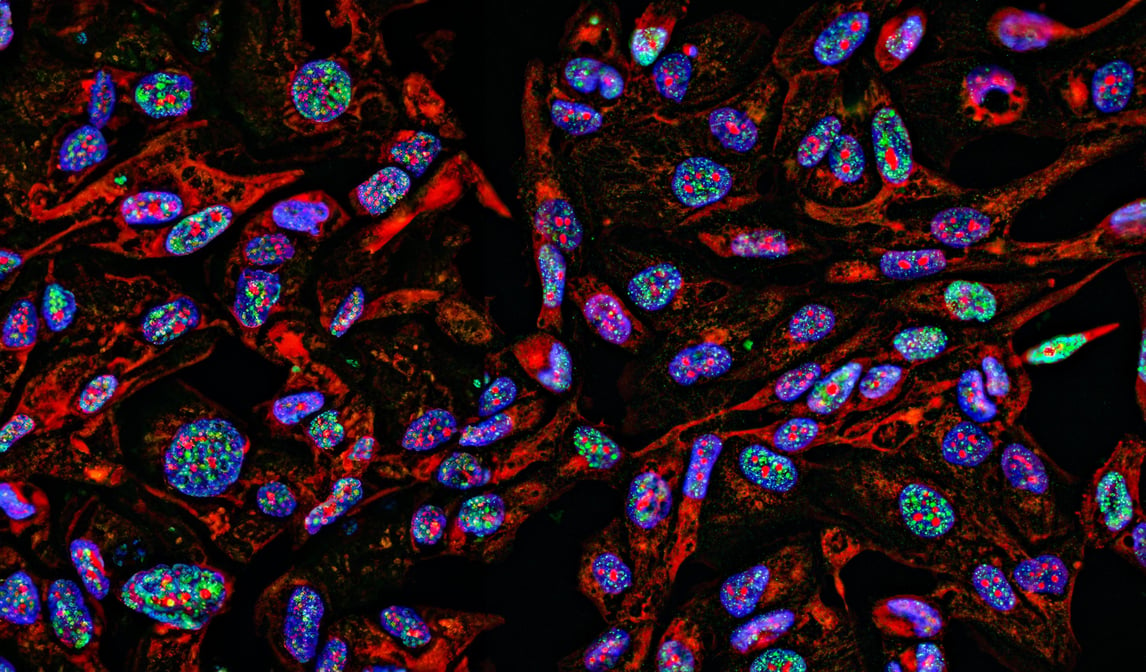

Fluorescence In Situ Hybridization
Identify cytogenetic abnormalities and view spatial gene expression
Understand the spatial biology and cytogenetic status of your preclinical or clinical trial samples
Precision’s FISH capabilities
Precision’s fluorescence in situ hybridization service enables the detection of cytogenetic abnormalities at the single cell level.
- FISH in CTCs, CECs, FFPE, frozen tissue, and bone
- Detect cellular genetic aberrations: multiploidy, translocations, amplifications or deletions
- Custom FISH probe design services
- Commercially available FISH assays
- Proprietary disease-specific FISH panels
Sample types
- Tissues
- Cell lines
- CTCs
- Blood
Genetic Aberrations Detected
- Amplification
- Insertion
- Deletion
- Fusion, translocation
Precision’s ISH capabilities
In addition to examining changes in DNA by FISH, Precision for Medicine is also able to measure spatial gene expression using ACD’s RNAscope ISH assays and technology. This platform enables sensitive gene expression imaging at the single-cell level, and can be single-plex, multi-plex, and dual ISH-ICH.
We can implement commercially available or custom RNA ISH targets.
Sample Types
- CTCs
- Fresh biopsy tissue
- frozen biopsy tissue
- FFPE slide / tissue block
Analyses
- Specific gene expression levels
- RNA localization information

Use case: FISH on circulating tumor cells (CTCs) in non-small-cell lung cancer
Cytogenetic analysis of CTCs often provides information regarding diagnosis, prognosis and therapeutic surveillance of cancer patients. At Precision we have developed DNA FISH assays to cytogenetically analyze CTCs after enrichment from patient whole blood.
Our standard workflow is to first isolate CTCs using ApoStream, followed by analysis. Through sequential processing and analysis we can also identify genetic aberrations in specific CTC phenotypes.
.jpg?width=2000&name=iStock-1486213181%20(1).jpg)
Global reach, multi-site support
Our FISH/ISH assay services support preclinical and clinical research, including multi-site studies, conducted anywhere in the world.
Working with Precision
Precision’s specialty lab scientists take a collaborative and consultative approach to projects and can provide recommendations on biomarker assay strategies and implementation. Services can be provided individually or as part of a comprehensive therapeutic development package including biomarker assays and clinical trials.
Related Services
-
Explore

NGS
ExploreServices including RNA-seq, whole exome sequencing, and targeted DNA/RNA sequencing utilizing both Illumina and Thermo-Fisher NGS platforms -
Explore

Multiplex Immuno-fluorescence
ExploreAutomated multiplex immunofluorescence services that enable quantitative visualization of up to 9 markers in tissue and liquid biopsies -
Explore
ApoStream®: CTC Liquid Biopsy
ExploreProprietary Precision technology for antibody-free isolation and concentration of target cells in liquid biopsy samples; enables analysis via methods including mIF, FISH, and NGS
